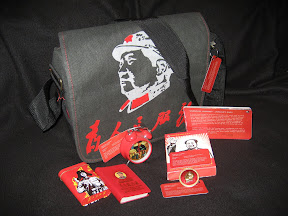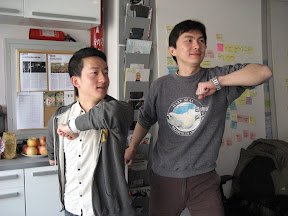MeMaories
A recent stroll through old town took me through back alleys, open air meat and vegetable markets, and of course, YuYuan Gardens - a tourist hotspot that I wasn’t expecting to find interesting at all. Except, I found Mao. Lots of Mao. Maybe after so many years of hardship, the Chinese are starting to laugh it off a little. Expression through design seems to be cathartic.
I’ve been seeing a lot of propaganda art reinterpreted everywhere, in everyday design and in high art, on t-shirts (at boutiques like Shirt Flag), and in art galleries (from the Moganshan enclave to the more institutionalized Shanghai Art Gallery). And then there’s the Propaganda Art Museum on HuaShan Lu and another museum with some 30,000 genuine pins from the cultural revolution in Shanghai.
China’s dear Chairman continues to be quite an icon here after his death. Just as Mickey D’s golden arches are a universally recognized symbol in the west, Mao’s portrait can be found on all sorts of knickknacks at every street corner in China. This month’s care package of design inspiration for my advocacy group in Palo Alto was a small subset of these things, which include a traditional book bag with a Mao screen print, a kitschy but hilarious alarm clock. Mao’s little red book (with English translation), a deck of cards with a different propaganda graphic on each face, a genuine Mao pin from 1968, and a smoke box with a forward marching laborer.


Before I mailed the package, I laid everything out for the Shanghai IDEO-ers to respond to. Andy Xu left me a note that said: ‘A feeling of warmth’. He then explained to me that although years of hardship ensued because of the Cultural Revolution, in general, the older generation feels that the times past are still simpler than the capitalistic chaos today. Many Chinese people continue to collect me-mao-rabilia with historical meaning to remind them of the old days and to bring them good luck.

This gives me some clue as to why design expression is still so young here. For most of the 20th century, the only government sanctioned and heavily promoted designs for products and services were political in nature. Design that the everyman experienced in every day life was propaganda in some form – from movies, to playing cards.
Now the doors of the world are open to China and its designers. How will old symbols be reinterpreted and new symbols integrated?

0 Comments:
Post a Comment
<< Home